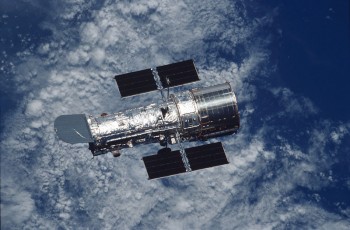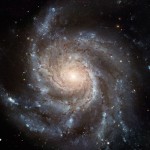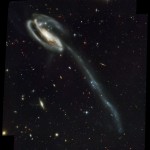The Hubble Space Telescope (HST) is considered one of the greatest leaps in astronomy since Galileo first put a telescope to his eye back in the early 1600s, thanks in large part to its spectacular images of the universe.
Hubble was put into orbit by the Space Shuttle Discovery mission STS-31 back in April 1990. Since then, it has given the world impressive views of the cosmos, while providing scientists with a unique insight into the universe.
While it is now considered to be one of the most successful NASA scientific endeavors ever, that wasn’t always the case. Because Hubble got off to a blurry start.
Shortly after its deployment, as scientists here on Earth were anxiously waiting for a glimpse at its first pictures, the Hubble sent back disappointing images that were low quality, blurred or unfocused, indicating a serious problem with its optical system.
After analyzing the flawed images, Hubble’s technical staff realized the cause of the problem was that the primary mirror had been ground to the wrong shape, despite the extreme measures taken to make it the most precisely configured mirror ever made up until then.
After the blurred images became public, NASA and the telescope itself became the targets of harsh criticism and the butt of many jokes. Many of the project’s critics considered Hubble to be an embarrassing flop.
But what the public failed to realize then was, despite the focus on its initial fuzzy images, the Hubble was still able to carry out a number of successful, productive observations.
Since the Hubble mission was designed to allow it to be serviced and updated regularly throughout its operation, scientists and technicians immediately began work on a solution to fix the HST’s “vision problem”.
The team ruled out bringing Hubble back to Earth and fixing it here because it would be too expensive and time-consuming. So they then decided to build the space telescope a set of “spectacles” to correct its ocular difficulties.

Hubble's final service call - STS-125 Mission Specialist Michael Good, May 2009 (Photo: NASA)
Hubble’s “glasses” – actually called the COSTAR corrective optics package – were installed by Space Shuttle Endeavour mission STS-61 crew members in December 1993.
Just a few weeks later, NASA declared the Hubble’s repair mission a complete success and backed up its claim by showing off the first of many much sharper Hubble images.
Since then, the HST has had four more service calls to repair and update it, with the last taking place in May 2009 by the crew of the Space Shuttle Atlantis mission STS-125.
Many of the discoveries made by the Hubble are taken for granted today, but the space telescope’s numerous significant accomplishments have made it one of the most important observatories in history.
What exactly has the Hubble given the science community? For starters, thanks to the Hubble, we were able to learn that the age of the universe is about 12 to 13 billion years, a much more accurate and focused calculation than the previously thought age of between 10 to 20 billion years.

From Hubble - Abell 1689, an immense cluster of galaxies located 2.2 billion light-years away. Dark matter cannot be photographed, but its distribution is shown in the blue overlay (ASA/ESA/JPL-Caltech/Yale/CNRS)
Without the Hubble, dark energy – a hypothetical form of energy that’s found throughout space and is believed responsible for the accelerating expansion of the universe – might still remain undiscovered.
The Hubble has provided our scientists with a way of observing the many stages of a galaxy’s evolution, providing them with insight into how galaxies form and develop.
The HST gave us an understanding of how new planets are made by showing us protoplanetary disks.
Thought to be the birthing grounds of new planets, these protoplanetary disks have been described as clumps of gas and dust around young stars.
The Hubble also helped scientists learn about powerful gamma-ray bursts that take place in distant galaxies when massive stars collapse.
And, with the release of its “Deep Field” images, Hubble has allowed us to look back more than 10 billion years in time, giving scientists a glimpse at more than 1,000 galaxies at various stages of their evolution.
Hubble’s Ultra Deep Field (HUDF) observation provided its most distant look of objects more than 12 billion light years away.
Of course, these are just only a few of the HST’s great number of achievements over the years.
Hubble’s last service call, in 2009, rejuvenated the telescope and is expected to extend its lifespan by at least four years.
Even as the Hubble continues to send back images of the heavens back to Earth, NASA is working on the next generation space telescope.
Called the James Webb Space Telescope, it will feature a large infrared telescope with a 6.5-meter primary mirror, as compared to Hubble’s 2.4 meter mirror.
While NASA works toward a 2018 launch date, the project faces cancellation by the U. S. Congress. According to the House Appropriations Committee, the Webb telescope “is billions of dollars over budget and plagued by poor management.”
One of the first scientists to develop the Hubble Mission is Dr. Edward J. Weiler, Hubble’s chief scientist from 1979 until 1998.
Dr. Weiler, now the associate administrator of the Science Mission Directorate at NASA Headquarters in Washington, D.C., recently spoke with VOA’s Julie Taboh about Hubble’s history and its many accomplishments throughout the years.
To listen to the interview, tune into this weekend’s “Science World” radio program or listen below.
[audio://blogs.voanews.com/science-world/files/2011/09/One-On-One-Weiler-Taboh.mp3|titles=One-On-One – Weiler-Taboh]Other stories we cover on the “Science World” radio program this week include:
- NASA considers leaving Space Station unmanned
- Scientists work on a safer sleeping sickness treatment
- UN chief demands action on climate change
- New member of human family tree discovered
- Maternal health experts share strategies for saving lives
Amazing images from the Hubble over the years – click on photo for larger image

The deepest portrait of the visible universe ever. (Photo: NASA/ESA/S. Beckwith(STScI) and The HUDF Team)



































“provided it’s most distant look of objects”
Sigh. For a website that also provides a link for learning English, you should be ashamed.
Look: “it’s” means “it is”.
“Its” is the possessive, without the apostrophe.
Please? Thanks. (Was that so hard?)
Hubble shows us God creating new suns and planets,while others are dying. Releasing energy, and mater. For the next generation to form, and grow. As we see Life doing, under a microscope.
How much proof do you need you dimwit. There is no God.